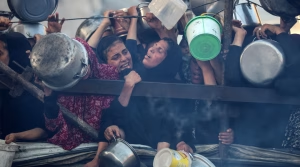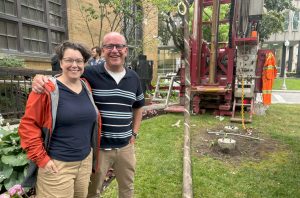Her people have been encased in clear plastic columns, rendered in acrylic paint and cast in bronze.
These have been Hannah Franklin’s methods of clocking humanity through time, their passage on this earth being the theme that has marked her work for almost 50 years.
Now she herself has reached a milestone, no longer able to make the art she loves and ready to close down her studio at 137 Saint-Ferdinand St., suite 220A, following an open house there on May 5 from 10 a.m.-6 p.m.
The event is spearheaded by her son, Jonathan Franklin, and curated by Joe Donohue, who also features some of her pieces on the Galerie Donohue website at galeriedonohue.com/hannah-franklin. The art ranges from thumb-size to human height.
“My mother is winding down her work and it’s an opportunity to have people share in the beauty and creativity of what she has done,” says her son.
That she is, as Donohue points out, “one of Canada’s finest artists” and internationally renowned, is a draw that few will want to miss.
Franklin launched her career in the 1970s by pioneering the medium of luminous polyester resins that resemble opaque, thin-shelled forms made in moulds, some columnar and others rounded.
From there, the resin became transparent, used as rougher shapes to trap enlarged photos of friends and loved ones like insects in amber.
It was then that she developed her paintings in acrylic, a polymer medium that is in the plastics family, to express the idea of people making their way on the earth as wandering figures.
These are so abstractly rendered that their reabsorption into the backgrounds of her compositions poignantly emphasizes their transience. She often mixes sand with pigment to underline the dust-to-dust aspect of human existence.
But depressing they are not. Franklin is a maven of primary colours, livening her canvases with large fields of red, yellow or blue, while introducing perhaps a slash of complementary orange at just the right juncture. At times, lines of her original poetry scratched into the paint are perceptible.
What inspires her themes of wanderings and wilderness makes them all the more remarkable. Franklin, who was born in 1937, escaped her doomed town of Hrubieszow, Poland, when the Holocaust threatened to swallow it up. She spent the war in Uzbekistan, living in a mud hut and evading scorpions and tar pits, while her father served on the Russian front. Her two baby brothers died from disease and starvation.
Still haunting her paintings are the wolves she imagined chasing her train back to Poland, memories that her family hoped she would leave behind when they immigrated to Canada in 1948.
Yet Franklin still loves nature and was known to be a master kayaker, cross-country skier and hiker.
READ: MUSEUM OF JEWISH MONTREAL EXHIBIT RECALLS ARTIST’S DISSIDENT SOVIET ANCESTOR
Her reverence for the Land of Israel and its ancient history is brought to bear in abstract-figurative paintings like The Journey 3. In it, human-like diagonals of paint walk toward Mount Sinai, as a sky-borne slash of blue paint represents the hand of God.
In paintings and sculptures, Franklin often depicts the transience of human presence by painting a figure alongside the shadow where it previously stood. Or, in the case of the sculpture Angel Flight, the cut-out, airy silhouette of a human in full stride is seen rising from its plaque in the embodiment of a solid angel.
The grace of the human outline recalls the delight she takes in ballet, a passion that prompted her to design sets for dance companies throughout her career. “All of tomorrow dance” is her wish that she has scratched into one canvas of her Desert Dance series. Franklin’s work will never stop dancing.






